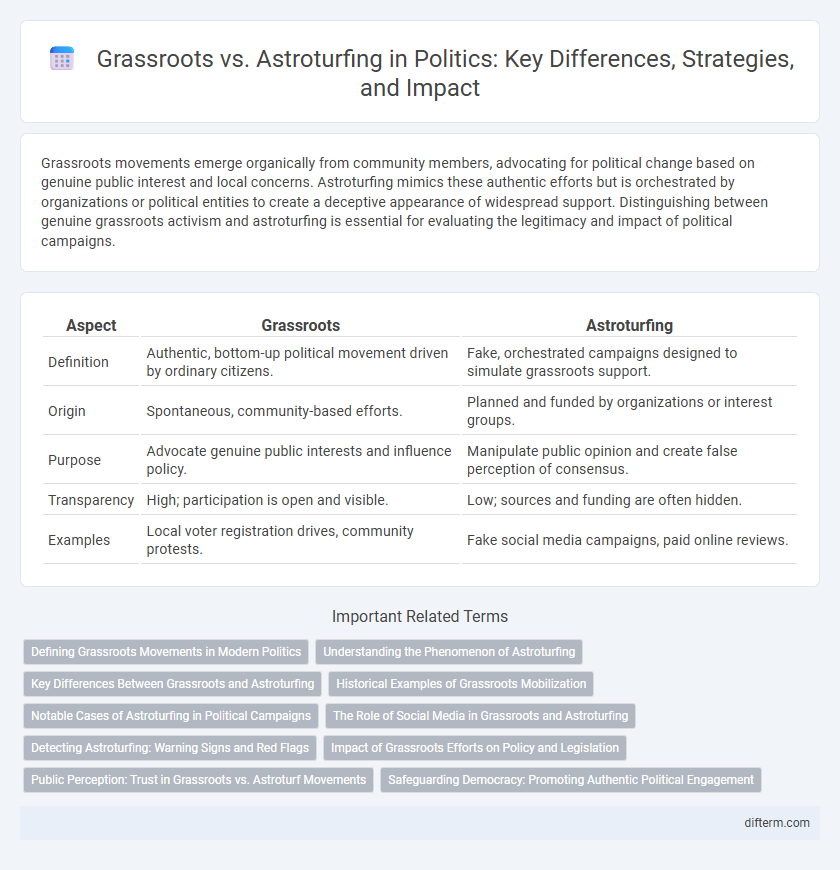Grassroots movements emerge organically from community members, advocating for political change based on genuine public interest and local concerns. Astroturfing mimics these authentic efforts but is orchestrated by organizations or political entities to create a deceptive appearance of widespread support. Distinguishing between genuine grassroots activism and astroturfing is essential for evaluating the legitimacy and impact of political campaigns.
Table of Comparison
| Aspect | Grassroots | Astroturfing |
|---|---|---|
| Definition | Authentic, bottom-up political movement driven by ordinary citizens. | Fake, orchestrated campaigns designed to simulate grassroots support. |
| Origin | Spontaneous, community-based efforts. | Planned and funded by organizations or interest groups. |
| Purpose | Advocate genuine public interests and influence policy. | Manipulate public opinion and create false perception of consensus. |
| Transparency | High; participation is open and visible. | Low; sources and funding are often hidden. |
| Examples | Local voter registration drives, community protests. | Fake social media campaigns, paid online reviews. |
Defining Grassroots Movements in Modern Politics
Grassroots movements in modern politics represent genuine, community-driven efforts where ordinary people mobilize to advocate for social or political change from the bottom up. These movements rely on authentic participation, local leadership, and organic growth rather than top-down coordination or corporate funding. Grassroots activism often shapes public policy by amplifying the voices of marginalized groups and fostering democratic engagement at the local level.
Understanding the Phenomenon of Astroturfing
Astroturfing refers to the deceptive practice of creating fake grassroots movements to manipulate public opinion and political outcomes. Unlike genuine grassroots campaigns driven by authentic citizen participation, astroturfing is often orchestrated by corporate interests or political groups using coordinated efforts and financial resources. Understanding astroturfing is crucial to identify inauthentic political advocacy and promote transparency in democratic processes.
Key Differences Between Grassroots and Astroturfing
Grassroots movements emerge organically from community members who mobilize to address shared concerns, reflecting genuine public opinion and local activism. Astroturfing, in contrast, is a deceptive strategy funded by organizations or interest groups designed to mimic grassroots support while manipulating public perception and policy debates. The key difference lies in authenticity: grassroots campaigns are driven by real, spontaneous citizen involvement, whereas astroturfing relies on artificial, orchestrated efforts to create a false impression of widespread consensus.
Historical Examples of Grassroots Mobilization
The 1960s Civil Rights Movement exemplified grassroots mobilization, where local communities organized protests and voter registration drives to challenge segregation and systemic racism. The Students for a Democratic Society (SDS) also demonstrated grassroots activism during the Vietnam War era by rallying youth and protesting government policies without centralized leadership. These examples highlight authentic citizen-driven efforts that contrast sharply with artificial astroturf campaigns funded or orchestrated by political interest groups.
Notable Cases of Astroturfing in Political Campaigns
Notable cases of astroturfing in political campaigns include the 2009 Citizens United controversy, where undisclosed corporate funding was funneled through fake grassroots organizations to influence elections. The 2016 U.S. presidential election saw astroturfing via social media bots and fake accounts designed to simulate public support or opposition. Another example is the UK's Brexit referendum, where some campaigns utilized covert astroturfing tactics to sway voter opinion under the guise of legitimate grassroots movements.
The Role of Social Media in Grassroots and Astroturfing
Social media platforms amplify grassroots movements by enabling authentic, decentralized citizen engagement and rapid information dissemination, fostering genuine community-driven campaigns. Conversely, astroturfing exploits these platforms through coordinated fake accounts and manipulated content to create misleading impressions of widespread support. The algorithmic design of social media intensifies the visibility of both organic activism and engineered campaigns, complicating the ecosystem of political influence.
Detecting Astroturfing: Warning Signs and Red Flags
Detecting astroturfing involves identifying unnatural patterns such as coordinated messaging from multiple accounts with identical language, sudden surges in online activity, and lack of verifiable grassroots origins. Warning signs include the absence of genuine community engagement, repeated use of scripted talking points, and promotion by anonymous or bot-like profiles. Red flags also encompass disproportionate amplification by paid influencers or organizations hiding behind false grassroots movements.
Impact of Grassroots Efforts on Policy and Legislation
Grassroots efforts significantly influence policy and legislation by mobilizing genuine community support that lawmakers recognize as authentic representation of constituents' interests. These campaigns often generate widespread public engagement, leading to increased pressure on legislators to address local and national issues. Studies show that policies emerging from grassroots movements tend to reflect broader public consensus and promote democratic accountability more effectively than astroturfing, which can distort the political process through manufactured support.
Public Perception: Trust in Grassroots vs. Astroturf Movements
Public perception heavily favors grassroots movements due to their authenticity and genuine community-driven origins, which foster higher trust among citizens and policymakers. Astroturf campaigns, often criticized for artificiality and hidden agendas, face skepticism and diminished credibility, impacting their overall effectiveness. Transparent communication and clear evidence of organic support remain key factors influencing public trust in political activism.
Safeguarding Democracy: Promoting Authentic Political Engagement
Authentic political engagement relies on genuine grassroots movements that reflect the true interests of the community, fostering transparent dialogue and democratic participation. In contrast, astroturfing manipulates public opinion by creating the illusion of widespread support through fabricated or corporate-backed campaigns, undermining trust in democratic institutions. Safeguarding democracy requires prioritizing transparency, accountability, and the amplification of authentic grassroots voices to ensure policymaking is genuinely representative.
Grassroots vs Astroturfing Infographic

 difterm.com
difterm.com